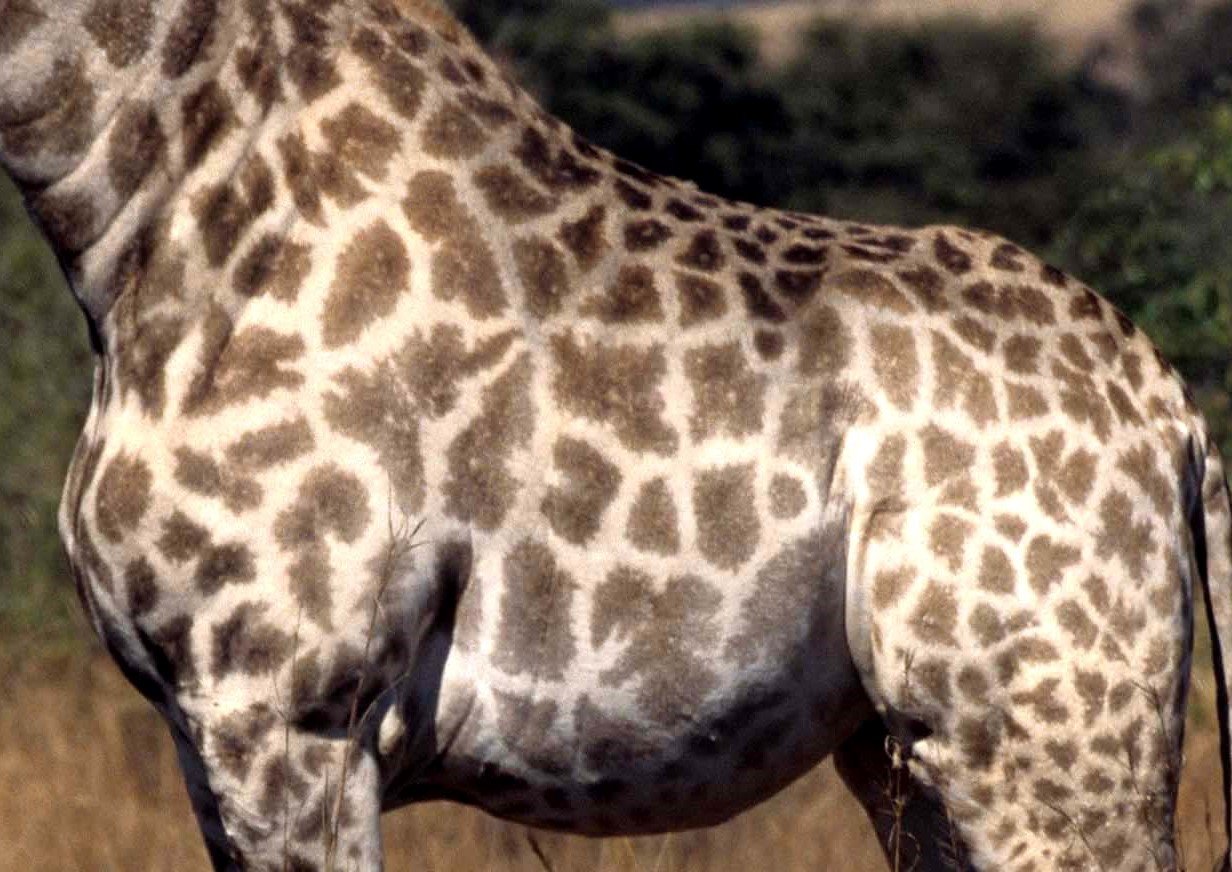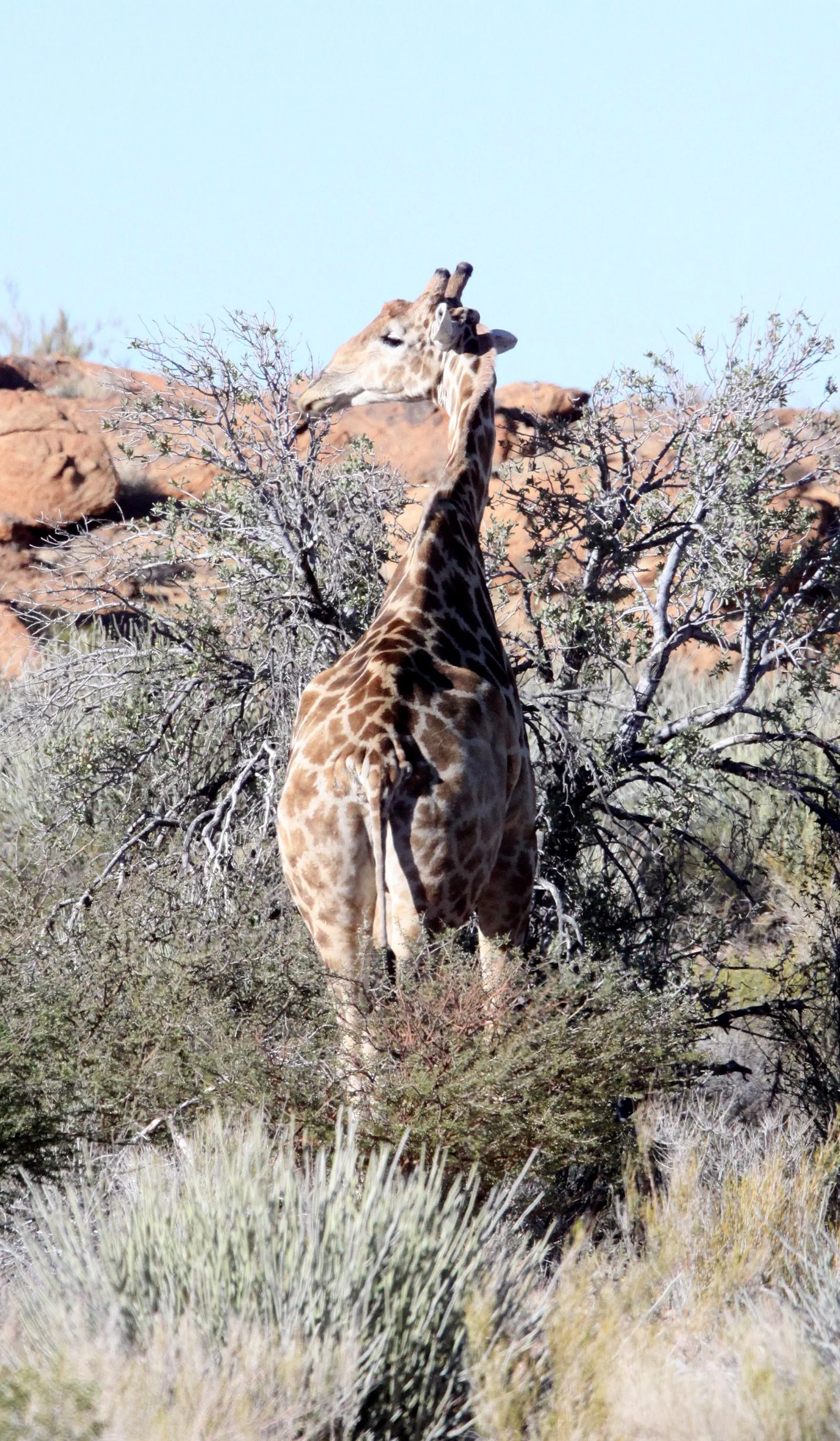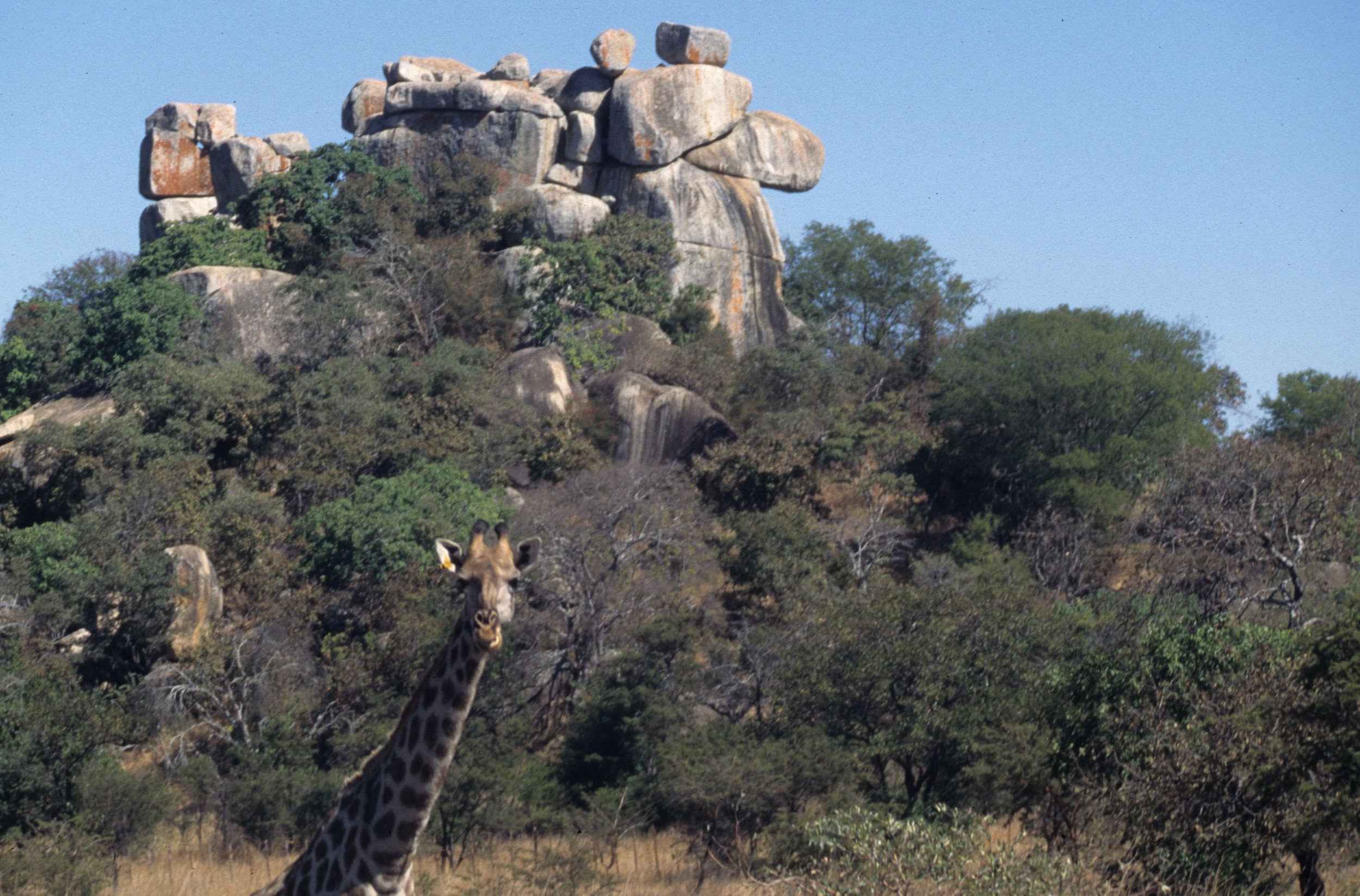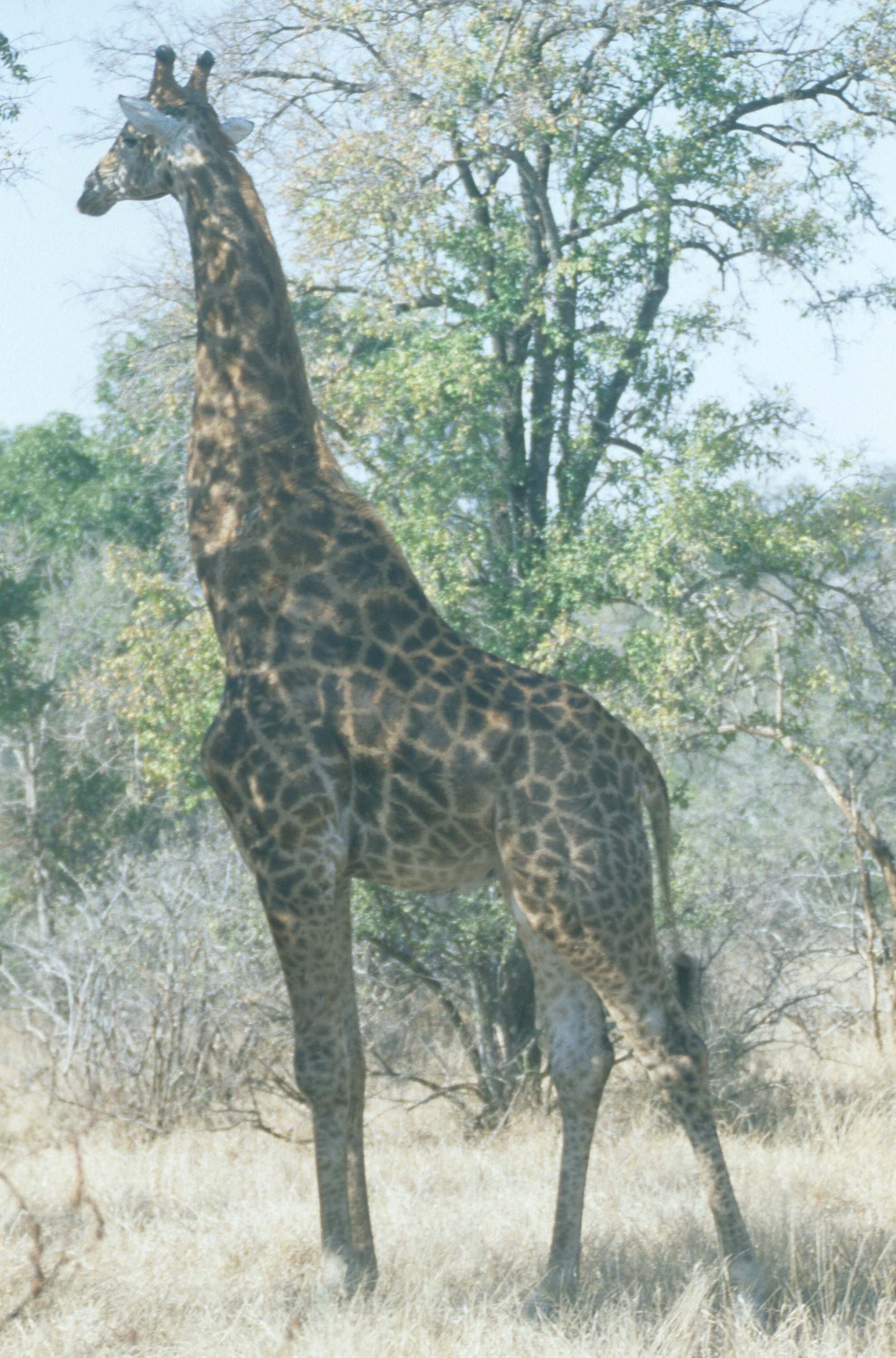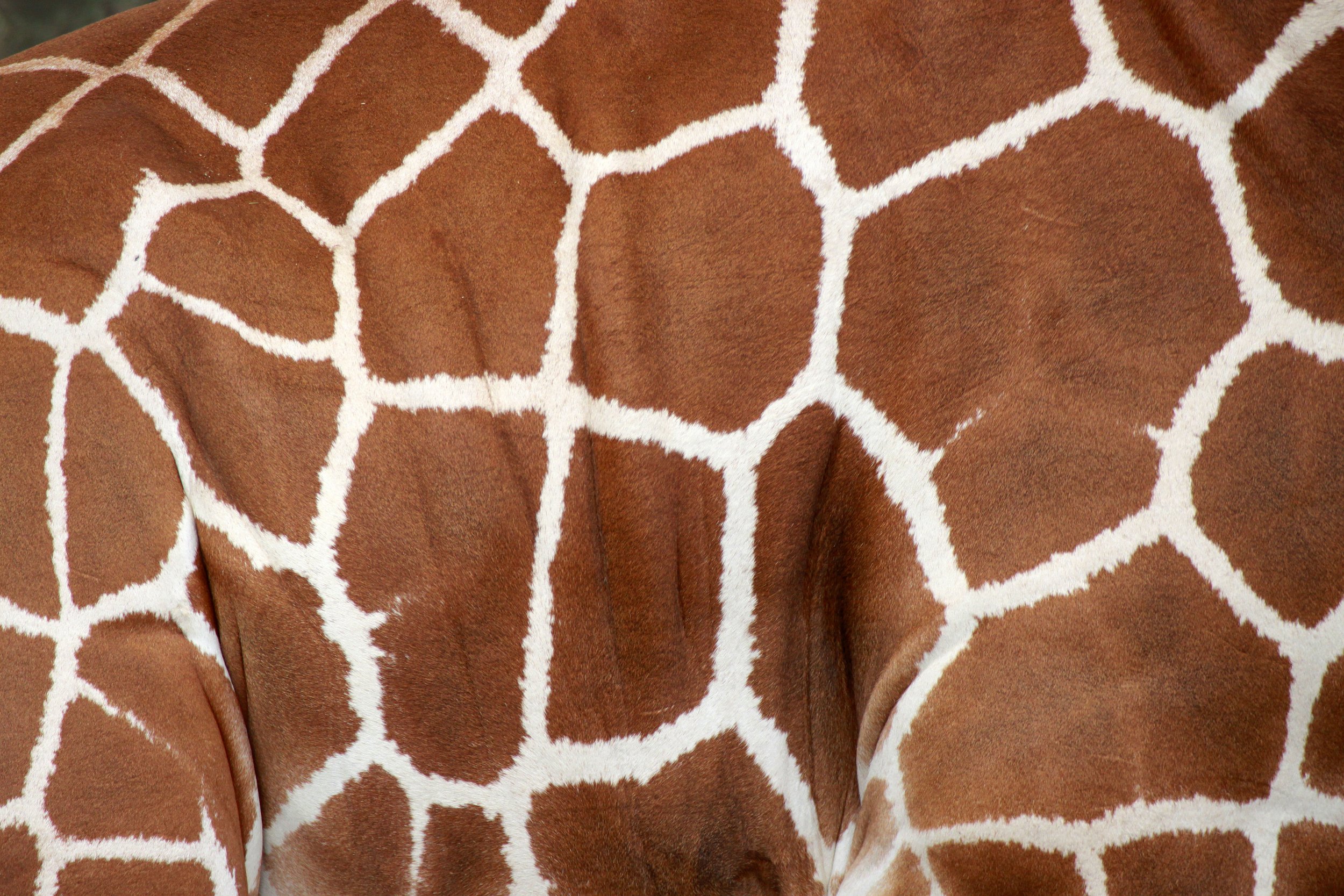
Giraffidae
The Giraffidae are a family of ruminant artiodactyl mammals that share a common ancestor with deer and bovids. This family, once a diverse group spread throughout Eurasia and Africa, presently comprises only two extant genera, the giraffe (one or more species of Giraffa, depending on taxonomic interpretation) and the okapi (the only known species of Okapia). Both are confined to sub-Saharan Africa: the giraffe to the open savannas, and the okapi to the dense rainforest of the Congo. The two genera look very different on first sight, but share a number of common features, including a long, dark-coloured tongue, lobed canine teeth, and horns covered in skin, called ossicones.
The giraffe stands 5–6 m (16–20 ft) tall, with males taller than females. The giraffe and the okapi have characteristic long necks and long legs. Ossicones are present on males and females in the giraffe, but only on males in the okapi.
Giraffids share many common features with other ruminants. They have cloven hooves and cannon bones, much like bovids, and a complex, four-chambered stomach. They have no upper incisors or upper canines, replacing them with a tough, horny pad. An especially long diastema is seen between the front and cheek teeth. The latter are selenodont, adapted for grinding up tough plant matter. Like most other ruminants, the dental formula for giraffids is 0.0.3.33.1.3.3. Giraffids have prehensile tongues (specially adapted for grasping).
The extant giraffids, the forest-dwelling okapi and the savannah-living giraffe, have several features in common, including a pair of skin-covered horns, called ossicones, up to 15 cm (5.9 in) long (absent in female okapis); a long, black, prehensile tongue; lobed canine teeth; patterned coats acting as camouflage; and a back sloping towards the rear. The okapi's neck is long compared to most ruminants, but not nearly so long as the giraffe's. Male giraffes are the tallest of all mammals: their horns reach 5.5 m (18 ft) above the ground and their shoulder 3.3 m (11 ft), whereas the okapi has a shoulder height of 1.7 m (5 ft 7 in).
Captive Okapi at the Henry Doorly Zoo, Omaha Nebraska
The two extant genera are now confined to sub-Saharan Africa. The okapi is restricted to a small range in the northern rainforest of the Democratic Republic of Congo. Although the range of the giraffe is considerably larger, it once covered an area twice the present size — all parts of Africa that could offer an arid and dry landscape furnished with trees.
Eight species taxonomy:
Giraffa camelopardalis
Giraffa antiquorum
Giraffa peralta
Giraffa giraffa
Giraffa angolensis
Giraffa reticulata
Giraffa tippelskirchi
Giraffa thornicrofti
Angolan Giraffe
The Angolan Giraffe (Giraffa camelopardalis angolensis or Giraffa giraffa angolensis), also known as the Namibian giraffe, is a subspecies of giraffe that is found in northern Namibia, south-western Zambia, Botswana, and western Zimbabwe.
A 2009 genetic study on this subspecies suggests the northern Namib Desert and Etosha National Park populations each form a separate subspecies. However, genetic studies based on mitochondrial DNA do not support the division into two subspecies., but could identify giraffes in southern Zimbabwe as the Angolan giraffe, suggesting a further eastward distribution than expected.
This subspecies has large brown blotches with edges that are either somewhat notched or have angular extensions. The spotting pattern extends throughout the legs but not the upper part of the face. The neck and rump patches tend to be fairly small. The subspecies also has a white ear patch.
Home range size of Angolan giraffes was found to be larger in unproductive areas such as the Namib Desert and much smaller in more productive areas such as Lake Manyara National Park. However, that home range size could be affected by abiotic(e.g climate), biotic(e.g forage availability, predator densities) and human influence(e.g population growth)
As far as seasonal movements of giraffes were concerned, they were not as distinctive as those in other giraffe populations around the world. Male Giraffe moves longer than Female giraffe and also it has longer average daily movement (5.64km compared to 1.87km in 180 days during hot-dry season).
Angolan Giraffe (Giraffa camelopardalis angolensis) - most images from Etosha and surrounding areas in Namibia and Caprivi.



























































































































Masai Giraffe
The Masai Giraffe (Giraffa camelopardalis tippelskirchi or Giraffa tippelskirchi), also spelled Maasai giraffe, and sometimes called Kilimanjaro giraffe, is a subspecies or species of giraffe. It is native to East Africa. The Masai giraffe can be found in central and southern Kenya and in Tanzania. It has distinctive, irregular, jagged, star-like blotches that extend from the hooves to its head. The Masai giraffe is currently the national animal of Tanzania.
The IUCN currently recognizes only one species of giraffe with nine subspecies The Masai giraffe was described and given the binomial name Giraffa tippelskirchi by German zoologist Paul Matschie in 1898, but current taxonomy refers to Masai giraffe as Giraffa camelopardalis tippelskirchi. The Masai giraffe was named in honor of Herr von Tippelskirch, who was a member of a German scientific expedition in German East Africa to what is now northern Tanzania in 1896. Tippelskirch brought back the skin of a female Masai giraffe from near Lake Eyasi which was later on identified as Giraffa tippelskirchi. Alternative taxonomic hypotheses have proposed Masai giraffe may be its own species.
The Masai giraffe is distinguished by jagged and irregular spots on its body. Its geographic range includes various parts of eastern Africa. It is the largest-bodied giraffe species, making it the tallest land animal on Earth. Bulls are generally larger and heavier than cows, weighing close to 1,300 kilograms (2,900 pounds) and growing up to 5.5 meters (18 feet) in height. In the wild, individuals can live to be around 30 years of age, and in most cases can live longer in captivity.[9] The Masai giraffe's most famous feature, its neck, contains seven vertebrae and makes up roughly one third of its body height. Its long and muscular tongue, which can be up to 50 centimeters (20 inches) in length, is prehensile and allows it to grab leaves from tall trees that are inaccessible to other animals. The tongue's darker pigment is believed to function as a natural sunscreen and prevent sunburn. On top of the head are two bony structures called ossicones which are covered by thick skin and have dark hair on the tips. These can be used during fights to club its opponent. Bulls usually have an extra ossicone present between the eyes. When galloping the Masai giraffe has been recorded to reach speeds of almost 64 kilometers per hour (40 miles per hour).
Masai giraffes are considered endangered by the IUCN, and the Masai giraffe population declined 52% in recent decades due to poaching and habitat loss. The population amounts to 32,550 in the wild. Demographic studies of wild giraffes living inside and outside protected areas suggest low adult survival outside protected areas due to poaching and low calf survival inside protected areas due to predation; these are the primary influences on population growth rates. Survival of giraffe calves is influenced by the season of birth and the seasonal local presence or absence of long-distance migratory herds of wildebeest and zebra. Metapopulation analysis indicated protected areas were important for keeping giraffes in the larger landscape.
In situ conservation of Masai giraffes is being done by several government agencies, including the Kenya Wildlife Service, Tanzania National Parks, Zambia Wildlife Authority; and non-governmental organizations including PAMS Foundation and the Wild Nature Institute. Community-based wildlife conservation areas have also been shown to be effective at protecting giraffes.
Over 100 Masai giraffe live under human care in AZA accredited zoos in the United States. At several zoos, Masai giraffe cows have become pregnant and successfully given birth.
Masai giraffes can suffer from giraffe skin disease, which is a disorder of unknown etiology that causes lesion on the forelimbs. This disorder is being further investigated to better understand mortality in this species.
The Masai Giraffe (Giraffa camelopardalis tippelskirchi or Giraffa tippelskirchi) from misc locations in Kenya and Tanzania:


























































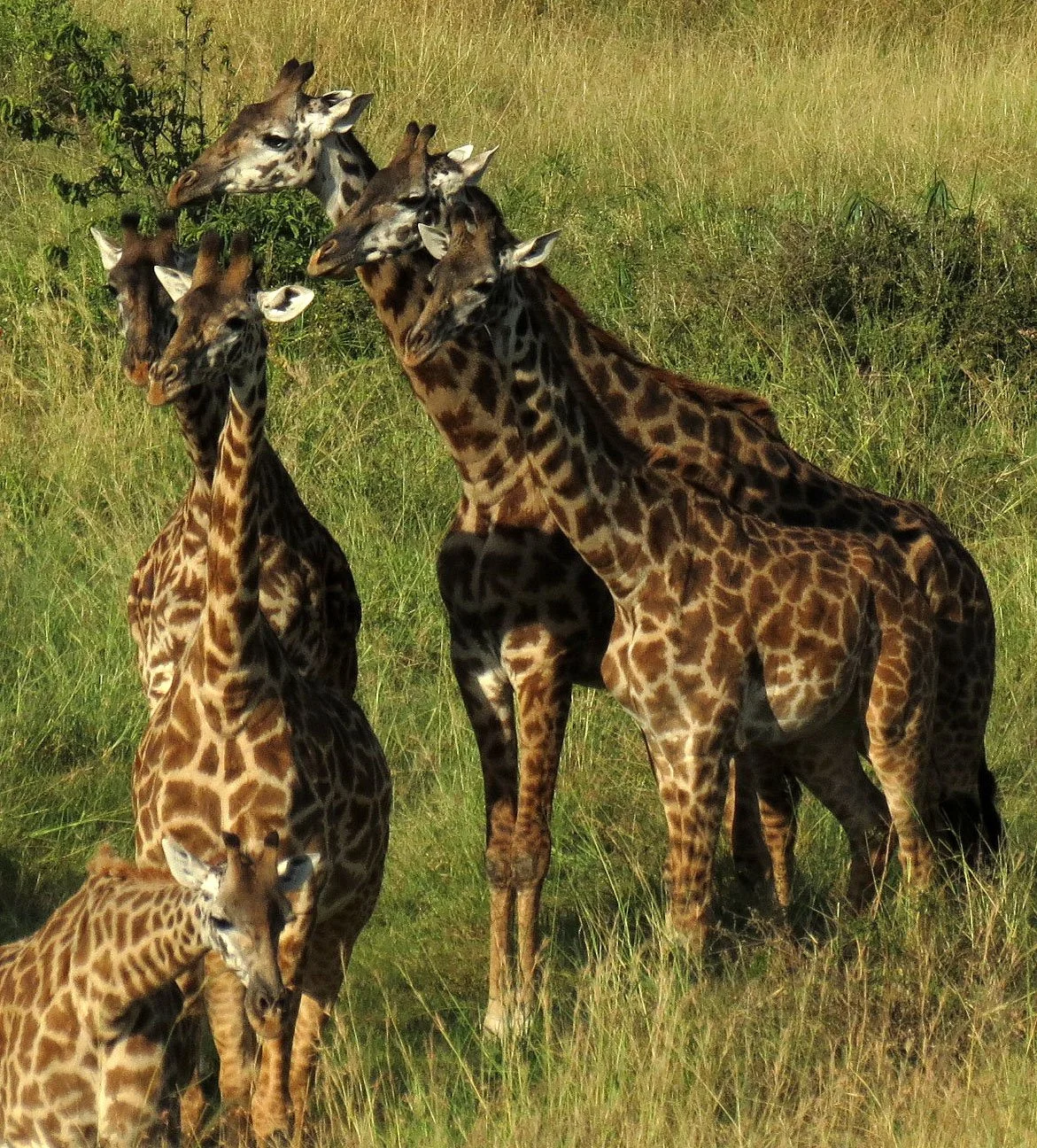



























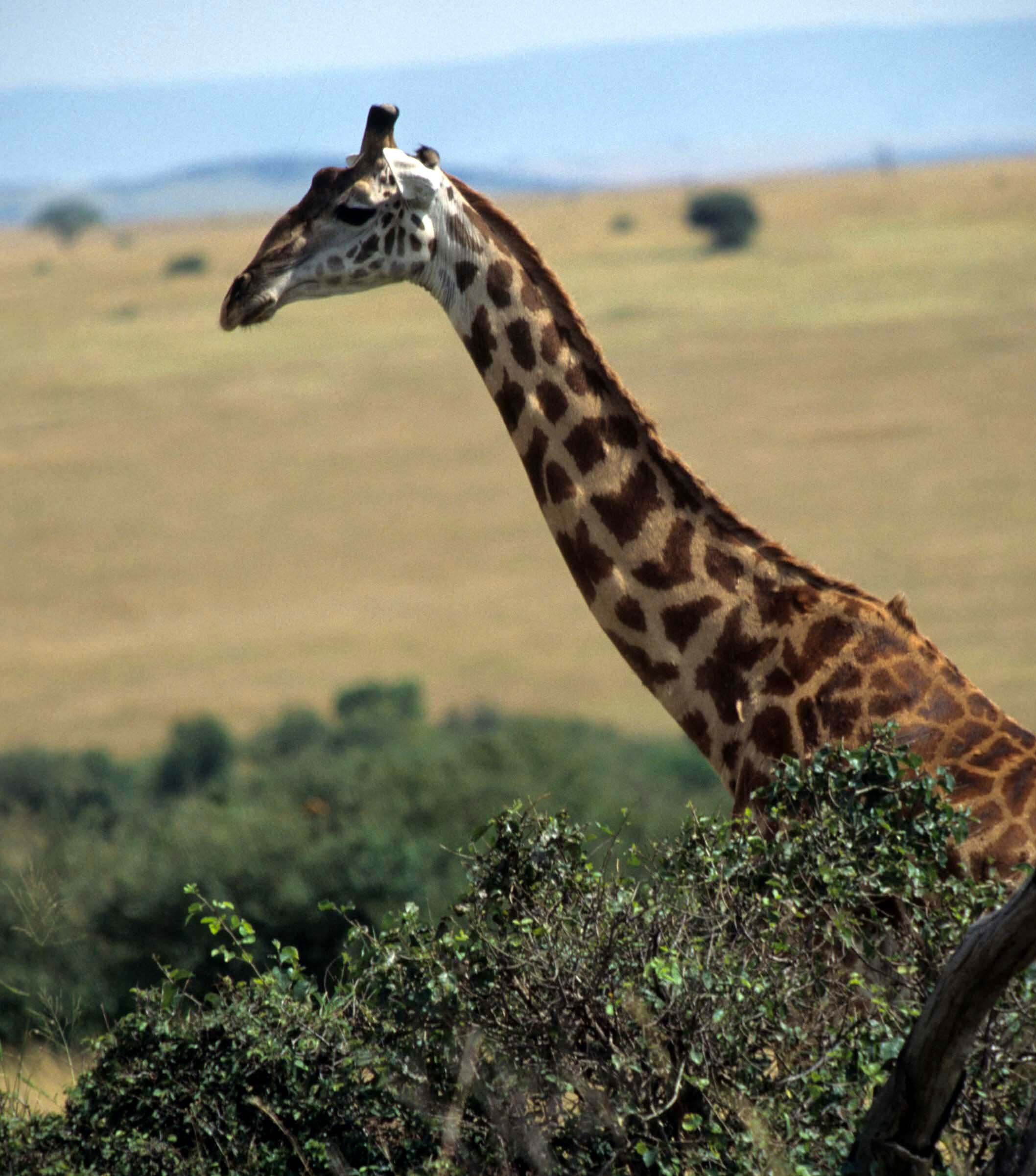












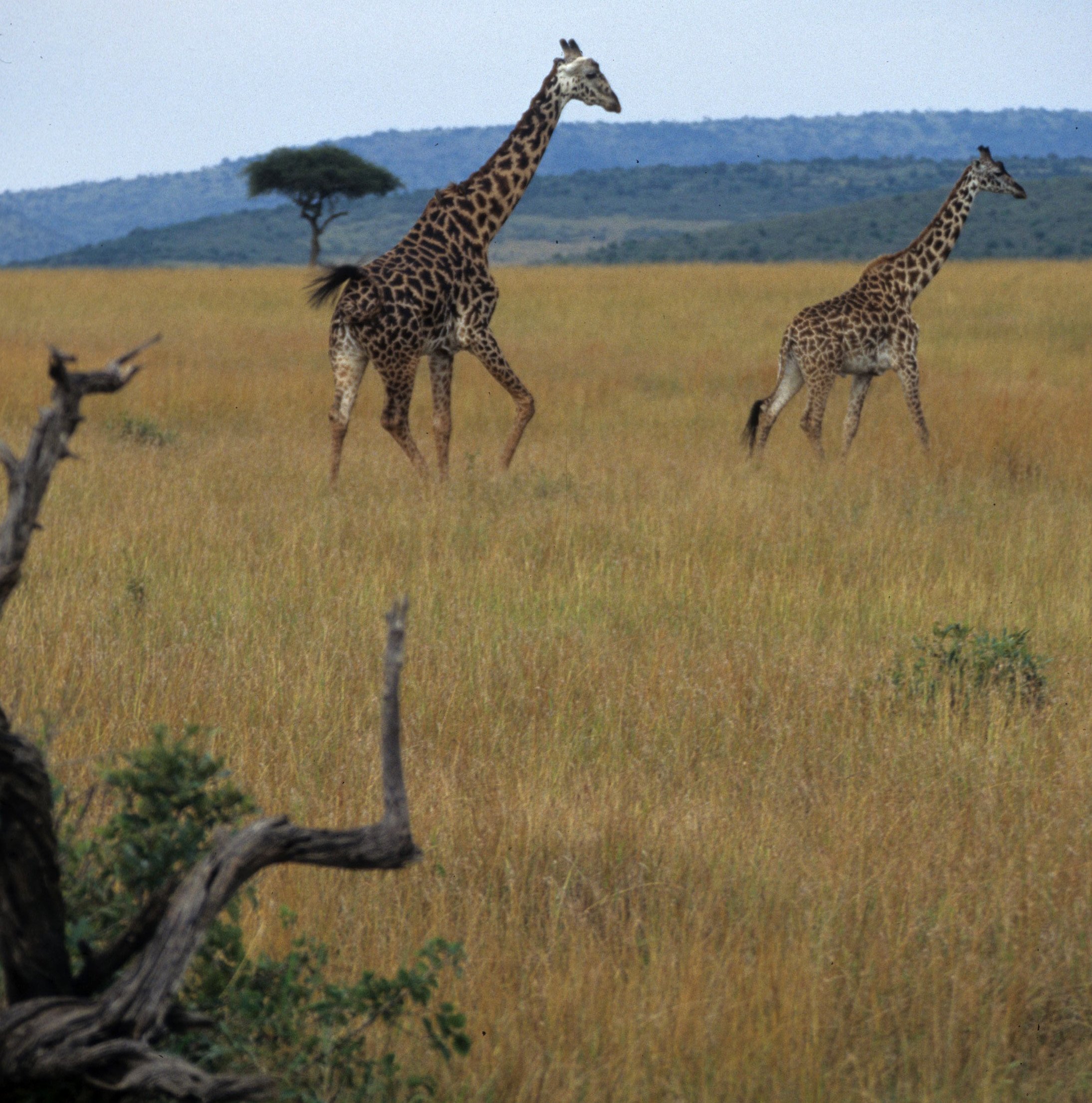






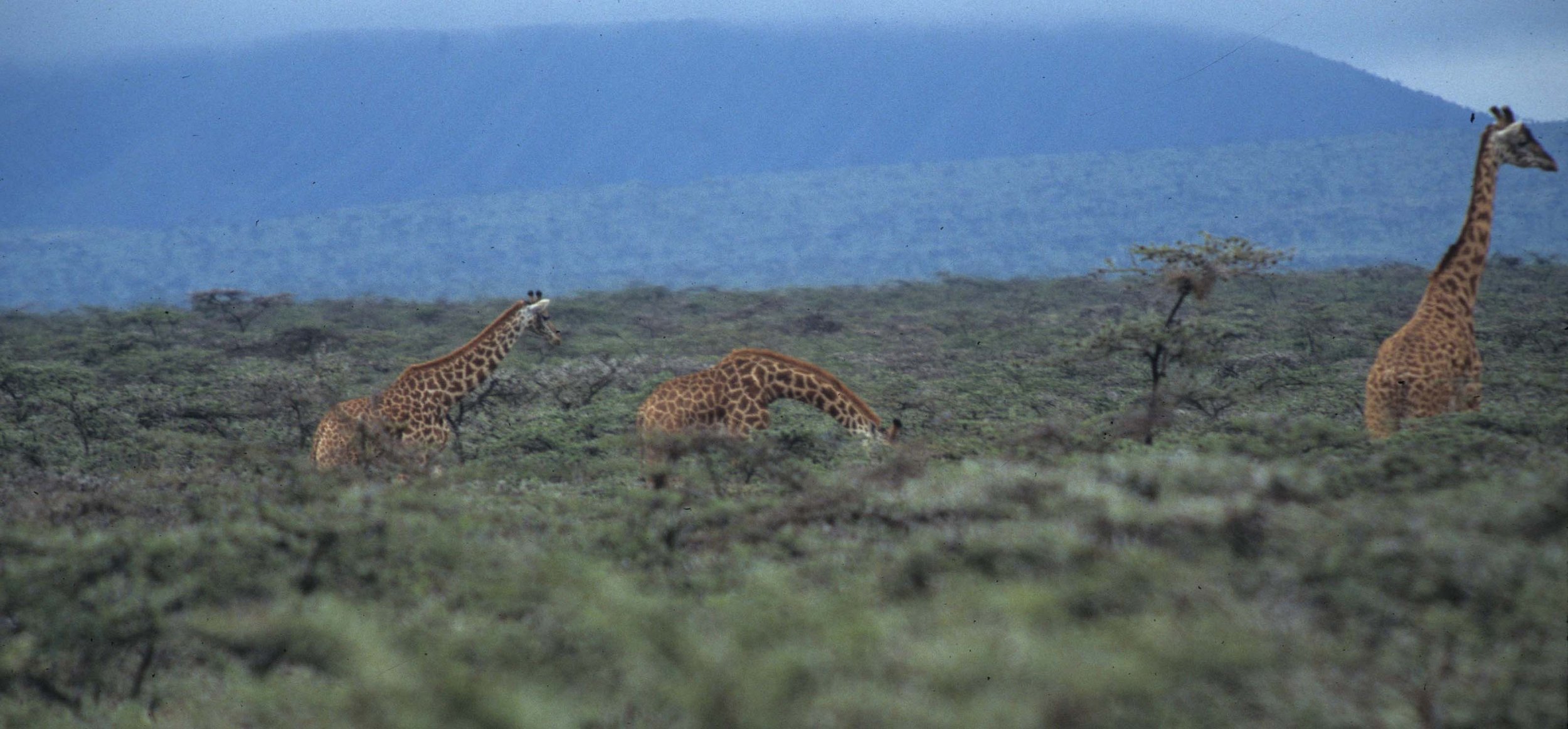














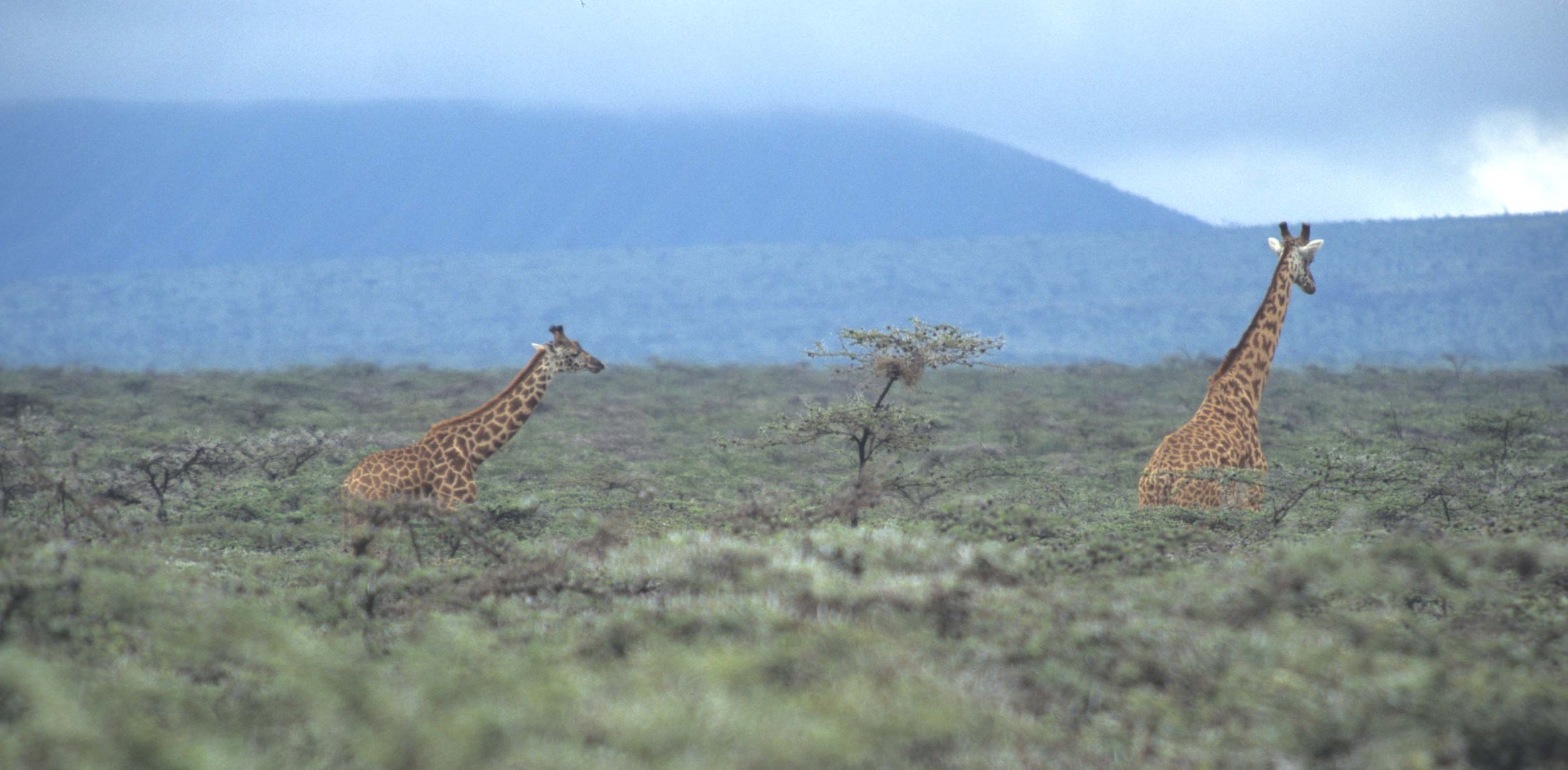



Reticulated Giraffe
The Reticulated Giraffe (Giraffa camelopardalis reticulata or G. reticulata), also known as the Somali giraffe, is a subspecies or species of giraffe native to the Horn of Africa. It lives in Somalia, southern Ethiopia, and northern Kenya. There are approximately 8,500 individuals living in the wild.
Reticulated giraffes can interbreed with other giraffe species in captivity or if they come into contact with populations of other species in the wild. Together with the Rothschild's giraffe, it is the giraffe most commonly seen in zoos. Its coat consists of large, polygonal, liver-colored spots outlined by a network of bright white lines. The blocks may sometimes appear deep red and may also cover the legs.
The IUCN currently recognizes only one species of giraffe with nine subspecies, one of which is the reticulated giraffe. All living giraffes were originally classified as one species by Carl Linnaeus in 1758. The subspecies was described and given a binomial name Giraffa reticulata by British zoologist William Edward de Winton in 1899.
Reticulated giraffes historically occurred widely throughout Northeast Africa. Their favored habitats are savannas, woodlands, seasonal floodplains, and rainforests.
To save the remaining 9,000, or so, Reticulated giraffes, several conservation organizations have been formed. One of these organizations is San Diego Zoo Global's "Twiga Walinzi" (meaning Giraffe Guards) initiative. Their work includes hiring and training local Kenyans to monitor 120 trail cameras in Northern Kenya (Loisaba Conservancy and Namunyak Wildlife Conservancy) that capture footage of wild giraffes and other Kenyan wildlife; developing a photo ID database so individual giraffes can be tracked; informing rangers of poaching incidents and removing snares; caring for orphaned giraffes; and educating communities about giraffe conservation.
Reticulated Giraffe (Giraffa camelopardalis reticulata or G. reticulata) from Shaba and Samburu, Kenya


























































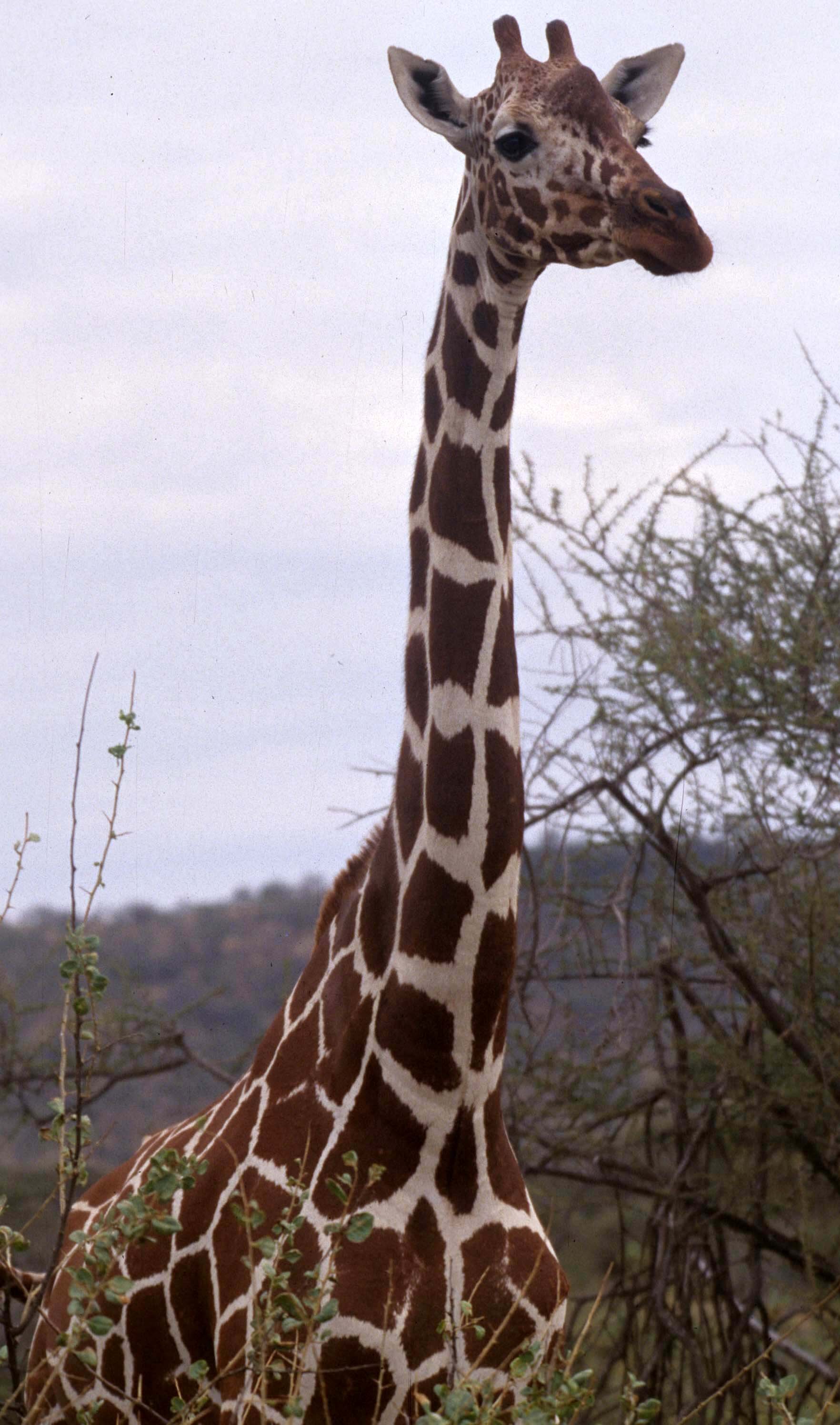







Rothschild's Giraffe
Rothschild's Giraffe (Giraffa camelopardalis rothschildi) is a subspecies of the Northern giraffe. It is one of the most endangered distinct populations of giraffe, with 1,399 mature individuals estimated in the wild in 2018.
The IUCN currently recognizes only one species of giraffe with nine subspecies. Giraffa camelopardalis rothschildi is named after the Tring Museum's founder, Walter Rothschild, and is also known as the Baringo giraffe, after the Lake Baringo area of Kenya, or as the Ugandan giraffe. All of those living in the wild are in protected areas in Kenya and Uganda. In 2007, Rothschild's giraffe was proposed as a separate species from other giraffe. In 2016, Rothschild's giraffe was proposed as conspecific with the Nubian giraffe (elevated to full species), but that taxonomy has not been widely adopted.
The Rothschild's giraffe is easily distinguishable from other subspecies. The most obvious sign is in the coloring of the coat or pelt. Whereas the reticulated giraffe has very clearly defined dark patches with bright-whitish channels between them, Rothschild's giraffe more closely resembles the Masai giraffe. However, when compared to the Masai giraffe, the Rothschild's ecotype is paler, the orange-brown patches are less jagged and sharp in shape, and the connective channel is of a creamier hue compared to that seen on the reticulated giraffe. In addition, Rothschild's giraffe displays no markings on the lower leg, giving it the impression of wearing white stockings.
Another distinguishing feature of Rothschild's giraffe, although harder to spot, is the number of ossicones on the head. This is the only Giraffa phenotype to be born with five ossicones. Two of these are the larger and more obvious ones at the top of the head, which are common to all giraffes. The third ossicone can often be seen in the center of the giraffe's forehead, and the other two are behind each ear. They are also taller than many other populations, measuring up to 5.88 metres (19.3 feet) tall. They can weigh up to 2,500 pounds.
Males are larger than females by a few hundred pounds and their two largest ossicones are usually bald from sparring. They usually tend to be darker in colour than the females, although this is not a guaranteed sexing indicator.
Isolated populations of Rothschild's giraffes live in savannahs, grasslands, and open woodlands of Uganda and Kenya. They are possibly regionally extinct from South Sudan and northeastern Democratic Republic of the Congo.
As of 2018, Rothschild's giraffe is classified as near threatened. Very few locations are left where Rothschild's giraffe can be seen in the wild, with notable spots being Lake Nakuru National Park in Kenya and Murchison Falls National Park in northern Uganda. Their predators are hyenas, lions, crocodiles, and leopards.
Two dwarf giraffes standing only 9.5 feet (2.9 m) tall have been spotted in Murchison Falls National Park. Scientists speculate their dwarfism may have been caused by inbreeding due to species decline.
Rothschild's Giraffe (Giraffa camelopardalis rothschildi) in Murchison Falls NP Uganda:

















































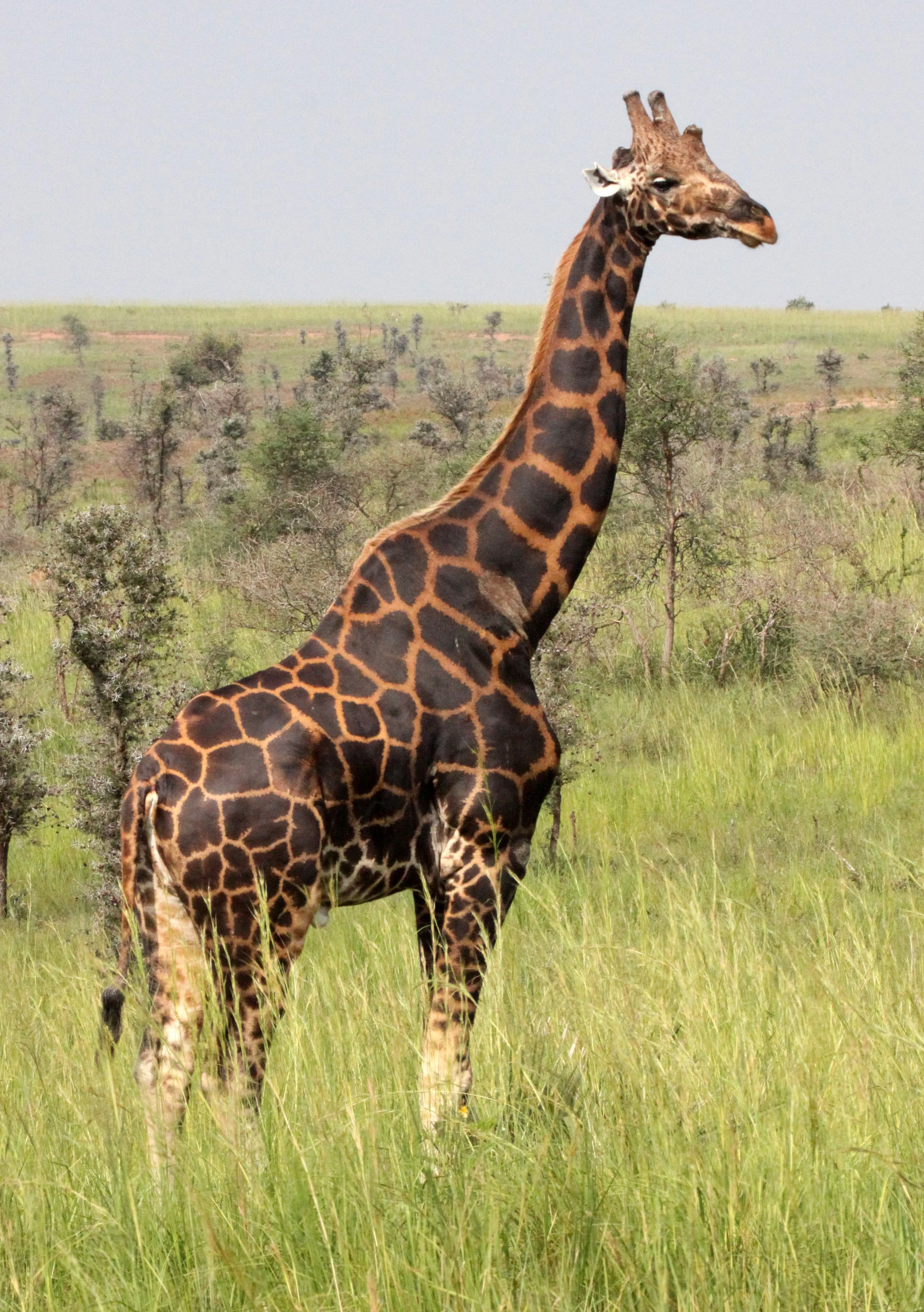















South African Giraffe
The South African Giraffe or Cape Giraffe (Giraffa camelopardalis giraffa) is a subspecies of giraffe found in South Africa, Namibia, Botswana, Zimbabwe and Mozambique. It has rounded or blotched spots, some with star-like extensions on a light tan background, running down to the hooves.
In 2016, the population was estimated at 31,500 individuals in the wild.
The IUCN currently recognizes only one species of giraffe with nine subspecies. The Cape giraffe, along with the whole species, were first known by the binomen Camelopardalis giraffa as described by German naturalist Johann Christian Daniel von Schreber in his publication Die Säugethiere in Abbildungen nach der Natur mit Beschreibungen (The Mammals Illustrated from Nature with Descriptions) during his travel in the Cape of Good Hope in 1784. Dutch naturalist Pieter Boddaert also described it under the binomial name Giraffa giraffa whilst also identifying the nominate specimen of said species under the ternary name Giraffa camelopardalis giraffa in 1785.
The South African giraffe has dark, somewhat rounded patches "with some fine projections" on a tawny background colour. The spots extend down the legs and get smaller. The median lump of males is less developed.
The South African giraffe is found in northern South Africa, southern Botswana, southern Zimbabwe, and south-western Mozambique. After local extinctions in various places, South African giraffes have been reintroduced in many parts of Southern Africa, including in Eswatini. They are common in both in and outside of protected areas. South African giraffes usually live in savannahs and woodlands where food plants are available. Giraffes are herbivorous. They feed on leaves, flowers, fruits and shoots of woody plants such as Acacia.
South African giraffes live in a fission–fusion society system based on factors such as sex, age, season, and kinship. This allows them to adapt to environmental changes.
At present, the South African giraffe population is estimated at 37,000 individuals, showing an increase of over 150% over the past three decades. The International Union for the Conservation of Nature, the body that administers the world's official endangered species list, announced in 2016 that it was moving the giraffe from a species of Least Concern to Vulnerable status in its Red List of Threatened Species report. That means the animal faces extinction in the wild in the medium-term future if nothing is done to minimize the threats to its life or habitat.
The South African Giraffe or Cape Giraffe (Giraffa camelopardalis giraffa) from various locations in South Africa:


